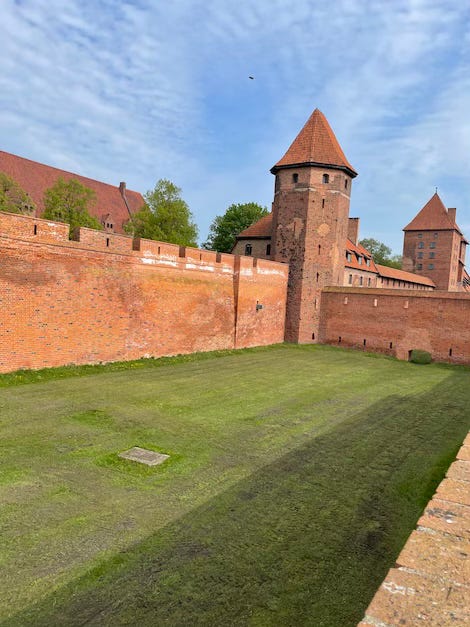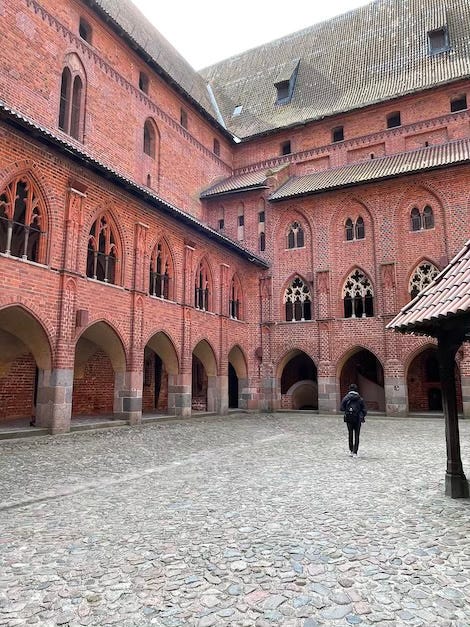Quote of the week
Poland was once a powerful imperial country that disappeared from maps of Europe for more than 100 years. It was partitioned and occupied by the Nazis and the Russians... We pop up and disappear and we do not trust what we are told to believe.
Olga Tokarczuk
Hello,
Just back from four days in Gdansk with surroundings. I went with a group of which I did not know anyone. It turned out to be a group of wonderful and jolly people. The guide, being a Pole living in Sweden, gave us a lot of history and present day information. Here some of the places we visited.
Malbork - Marienburg
This is really the main reason why I did go on this trip. It has been on my bucket list for a while. I have just read The Teutonic Knights by William Urban so I felt that I had an idea about the history. The castle was the headquarter of the knights for hundreds of years, while they were fighting their surroundings trying to christianise the heathens living around them.
Malbork Castle (Marienburg in German) was built in the 13th century and is the largest castle complex in Europe when looking at land area. It is a huge complex and the first view is very impressive. Even the last one. It was constructed as the headquarters of the Teutonic Order. The Order was, from the beginning, a military society, founded in Acre, Kingdom of Jerusalem, in 1191 by German merchants from Bremen and Lübeck. Their main purpose was to aid Christians on pilgrimages to the Holy Land and they established hospitals there. Their work continued until Christian forces were defeated. The Order moved on to Transylvania in 1211 to help defend eastern borders. Since then, during the Middle Ages, they were supporting Catholic rule in the Northern Crusades, and providing protection for Catholics in Eastern Europe.
The Order held the fort until the 16th century, having lived through various Grand Masters, some better, some worse. In 1410, a Polish-Lithuanian army defeated the order at the famous Battle of Grunwald, although the Order still held their headquarters. The Grand Master Albert of Brandenburg was the last in the line of masters, and he resigned in 1525 and converted to Lutheranism. I read somewhere he converted to Lutheranism because he did not want to live in celibat. However, the Order did keep rather big holdings in Germany until 1809. Not even they could stand against Napoleon so his ordering of its dissolution was the end of the Order, or part of it.
The Castle has been constructed and expanded over the centuries. When it was originally built is still debated. Most historians seem to accept that it was constructed between 1274 and 1406. There are three separate castles on the grounds: the High, Middle and Lower Castles. They are separated by dry moats and towers. It is an impressive construction of defensive walls, impossible to conquer.
We can’t ignore the Swedes in this area. They did actually occupy the castle during the Thirty Years’ War in 1626 (when King Gustaf II Adolf visited it) and 1629. Yet again they invaded and occupied it in 1656 to 1660 (when King Karl X Gustaf visited it). And, now again in 2024, a visit from a more friendly Swedish group.
Through the centuries the castle did deteriorate and in World War II, it was bombed and laid in ruins. A severe fire in 1959 caused further damages. From 1962 onwards restoration work has been in progress. There are more to do, but the work so far leave the visitor with an everlasting impression of its once grand status. If you are in the area, a visit is a must.

The Order still exists and since the early 19th century they do charitable work. The history of the Order is long and violent and if you are interested, do read more. They were at wars with everyone, different peoples and rulers, back and forth through the centuries. Even reading a whole book about them, I felt totally lost once I had finished it. Difficult to get an orderly overview.
Westerplatte
We took a boat from Gdansk, through the huge harbour, out to the peninsula of Westerplatte, located on the Baltic Sea coast. It is famous for the Battle of Westerplatte, which was the first clash between Polish and German forces, when the first shots were fired here on 1 September 1939, and thus World War II had started. The peninsula was granted to the independent state of Poland in the Treaty of Versaille after World War I. Gdansk was an independent city state, under the supervision of the League of Nations, but became allied with Germany with its predominantly German population.
Today it is a more peaceful place at the mouth of the canal and harbour area. We visited the memorial statue, walking in a circle up the road to the monument.
National Museum of Gdansk
This museum is hosted in the old Franciscian monastery. The aim of our visit, at the end of a long day, was mainly to have a look at Hans Memling’s triptych The Final Judgement. A fantastic work from one of the greatest painters of the 15th century. He was born in Germany (c 14.30 - 1494) and died in Bruges. He moved early on to the Netherlands and also spent time in Brussels. In 1465 he became a citizen of Bruges and one of its leading artists with his own workshop.
The Last Judgment was commissioned by Angelo Tani, a director of the Medici Bank in Bruges. When the triptych is closed one can see Tani and his wife kneeling in prayer. Unfortunately, the museum had closed the access to the back side of the triptych so we did not have the possibility to see it. The triptych had quite an adventurous trip. While it was shipped to Fiesole on a vassel, a Danzig privateer Paul Beneke, captured it in April 1473. The owner, of course, objected to the seizure of his painting and the matter went as far as the papal court. Danzig, however, defended Beneke and said it was a legitimate act of war as the Hanseatic League was at war with England at the time. The painting never reached the owner. It was placed in the Basilica of the Assumption but in the 20th century it was moved to its present location.
“The triptych depicts the Last Judgment during the second coming of Jesus Christ, the central panel showing Jesus sitting in judgment on the world, while St Michael the Archangel is weighing souls and driving the damned towards Hell; the left hand panel showing the saved being guided into heaven by St Peter and the angels; and the right-hand panel showing the damned being dragged to Hell.”
It is a fantastic painting. I have seen a few other paintings by Memling in Belgium and really love his work. The style of the painting made me think of Hieronymus Bosch. Or, more likely, Bosch might have been inspired by Memling, being somewhat later. Although Bosch definitely took the judgements a few steps further.
A few more things to remember from Gdansk, but that will be for next week.
















This is fascinating. I knew nothing, zero, zilch about this part of history or this place. Seeing your photos and hearing the background really brings it all to life. I can see why you wanted to visit -- it's quite remarkable.
Your posts are always great, it's like visiting the place myself. Lovely. Thanks a lot.